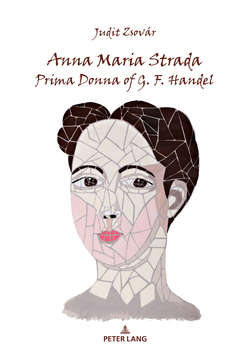Читать книгу Anna Maria Strada, Prima Donna of G. F. Handel - Judit Zsovár - Страница 13
На сайте Литреса книга снята с продажи.
Chapter One:
Early Years
ОглавлениеAfter setting out the (new) findings about Strada’s birth and death dates, parents, and possible educational background; the first chapter discusses the modern singing school (that of Pistocchi), the new singing style, and the singers connected to Strada. This leads further to an introduction of the cultural environment of the Venetian Republic as a venue of Strada’s first professional years, marked by her collaboration with Vivaldi, including the city’s operatic life with the attendant political, financial, and social networks. The second part of the chapter deals with Strada’s Venetian season of 1720/1721 at the Sant’Angelo theatre, with emphasis placed on her being as the first specifically high coloratura soprano that Vivaldi, as an opera composer, worked with, as well as her performances in Milan (1720 and 1721), Livorno (1722), and Lucca (1724).
Keywords: Milan, Venice, Vivaldi, S. Angelo, Teatro alla Moda, high coloratura soprano
Anna Maria Strada was born in 1703, and died in Naples on 20 July 1775.12 Francesco Saverio Quadrio (1744), in his list of the ‘female singers of dramatic poems’, notes her as a native of Bergamo.13 Her father might have been the bass Giuseppe Maria Strada, a member of the chapel choir of Santa Maria Maggiore in Bergamo between 1709 and 1711,14 who also sang in Milan, Parma, Casale Monferrato, Verona, Ferrara, Novara, and Brescia.15 Previously, Giuseppe received a monthly grant of three doppie from the Court of Mantova ←17 | 18→from 1 February 1696 onwards.16 It is probable that Anna Strada’s mother was Andriana Strada, also a singer, who appeared in various productions in Lombard cities like Crema and at the Gonzaga court in Mantua.17
Anna Strada, therefore, might well have received her first musical instructions from her parents, and it seems feasible that later she either spent a couple of years of training in Bologna, the centre of modern developments in singing methods, as well as the chief hub of mid-century operatic management markets, or rather was taught by someone local.18 It is also very likely that Strada received instrumental training on the harpsichord, a possibility which is supported by the fact that in 1731, when she was singing for Handel, she acquired an instrument built in 1729 by the harpsichord maker Burckhard Tschudi, a good friend of the composer (see Ch. 3).19
The modern singing school was founded and run by the castrato Francesco Antonio Pistocchi, the ‘father of modern good taste’, in 1702 after returning to Bologna from Germany.20 It could be that one of Pistocchi’s castrato pupils later became Strada’s teacher either in Bologna or somewhere in Lombardy: in Bergamo or Milan perhaps. Probably the master’s connections must have been helpful for the young soprano to get an appointment as virtuosa di camera at the court of Count Girolamo Colloredo-Waldsee, the new governor of Milan and patron of arts, in 1720.21 Upon arrival, Strada was discovered by Antonio Vivaldi, who engaged her for the 1720/1721 season at the Teatro Sant’Angelo in Venice.
The Bolognese contralto Antonia Merighi, one of Strada’s regular fellow singers, supposedly belonged to the circle of Pistocchi, and was strongly influenced by his pupils, Antonio Bernacchi and the tenor Annibale Pio Fabri, with whom she regularly performed.22 Intriguing is the fact that she used to sing with Strada in ←18 | 19→the same company in Venice; after which Merighi became engaged in Naples. When Merighi left the city in spring of 1724, Strada was appointed there. Then from 1729, they found themselves in the same troupe again, this time in Handel’s Second Academy in London, which also included Bernacchi. If Strada was trained either in Bologna or by somebody from the Bolognese school, she could have known Merighi and Bernacchi since her teens: Merighi was around thirteen years older, Bernacchi eighteen. Bearing in mind that Bernacchi, being Pistocchi’s pupil, carried on to teach his methods and later founded a school himself, and that he most probably gave some lessons to Merighi and even inspired the style of Farinelli, it seems very likely that Bernacchi himself might have been Strada’s teacher for a while.23 Strada’s assumed father, Giuseppe, sang together with Bernacchi ‒ for example in the production of Pollarolo’s Venceslao (Verona 1708; with the young Diana Vico as well) ‒ and therefore knew him personally, which makes this supposition feasible. During Strada’s possible training years (c. 1717‒20), Bernacchi appeared in several operas in Northern Italy (for example, in Milan in 1719, in Reggio nell’Emilia in 1718‒19 and in Venice between 1717 and 1719), and there is no reason why Strada could not travel to him regularly to receive singing lessons. Bernacchi may have passed on to her the idea of instrumental-type coloraturas, Lombardic rhythm, arpeggiato elements, volatine, various turn-figures, etc.: all inheritaed from Pistocchi.24 Either he or Merighi could have proposed Strada not only in Naples and for Handel, but earlier too, for Count Colloredo in Milan or even for Lucca and Livorno, where ←19 | 20→Strada was active in 1722‒23 and early 1724. Merighi, standing in the service of Violante Beatrice, the Grand Princess of Tuscany, could mention Strada’s name concerning the productions in the two Tuscan cities.
